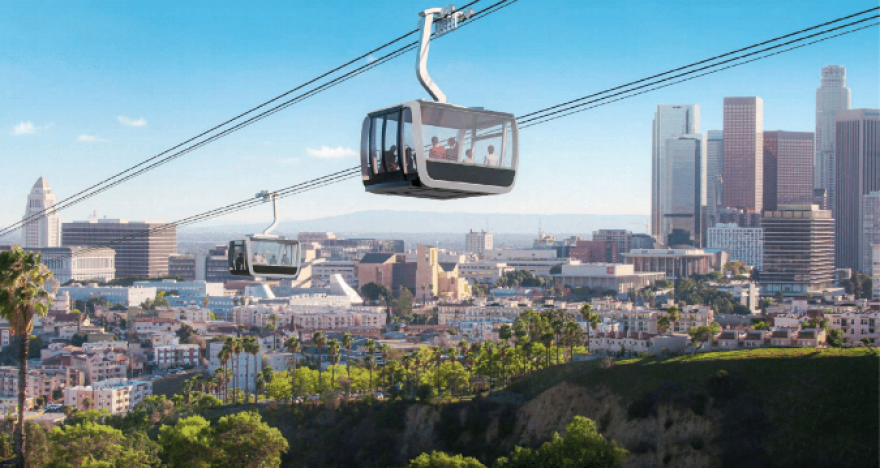Truth matters. Community matters. Your support makes both possible. LAist is one of the few places where news remains independent and free from political and corporate influence. Stand up for truth and for LAist. Make your year-end tax-deductible gift now.
LA’s Proposed Dodger Stadium Gondola Could Cost $500 Million

Metro’s final environmental impact report for the proposed gondola project that would connect Union Station to Dodger Stadium was released Monday with at least two “significant and unavoidable” effects.
How would the gondola work?
The gondola would be able to take 5,000 people from downtown L.A. to Dodger Stadium per hour in each direction, according to the report.
People would be able to get on the gondola at one of three passenger stations:
- Alameda Station, located between Los Angeles Street and Cesar E. Chavez Avenue
- Chinatown / State Park Station, located along Spring Street at the southernmost point of Los Angeles State Historic Park
- Dodger Stadium Station, located in the parking lot
The roughly 1-mile ride would take 7 minutes each way.
There would need to be an additional junction at the intersection of North Broadway and Bishops Road, but that would not be accessible to passengers. The project would also need to build a system of cables, towers, and cabins.
The gondola would be free for Dodger ticket holders, which the report said will take 3,000 cars off the streets of L.A. on game days.
If approved, the project would cost between $385 million and $500 million and take an estimated 25 months to build.
What are the “significant and unavoidable” impacts?
The proposed project would cause major construction noise and vibration, according to the report.
While most of the project would be on public property, some of the cables and cabins would pass over private property. Crews would be able to work on building the gondola between 7 a.m. and 9 p.m. Monday through Friday, as well as Saturdays and national holidays from 8 a.m. to 6 p.m.
Jon Christensen is a founder of the LA Parks Alliance, which is part of the Stop The Gondola coalition. He told LAist the project would be very disruptive to the Chinatown community.
“That whole stretch is going to be a construction zone for more than two years,” he said.
The report outlines ways to mitigate those effects, such as temporary noise barriers, noise suppression devices, and limiting idling equipment.
However, even if all of those steps are taken, the construction would remain “significant and unavoidable.”
How would the proposed gondola project impact traffic?
Some lanes would be closed between 10 and 24 hours a day during certain parts of construction, the report notes.
Before the gondola is given the green light, the project will need to have a detailed traffic plan that includes street closures, lights, and detours. That plan will also need to be submitted to the city for approval before a building permit is issued.
Some parking spaces at Dodger Stadium would also be temporarily closed during construction.
What would it take to upkeep?
The gondola would cost an estimated $8 million to $10 million a year to operate and maintain, officials say.
The system would also need to pass formal state testing at least every seven years, which means it would be closed for a few days each time.
Any routine maintenance would be worked on overnights, according to the report.
What’s next for the proposal?
The Metro Board of Directors will need to sign off on the final report — and then the project.
The gondola proposal also needs approval from the city of L.A., Caltrans, the California Department of Parks and Recreation, and the California Division of Occupational Safety and Health.








